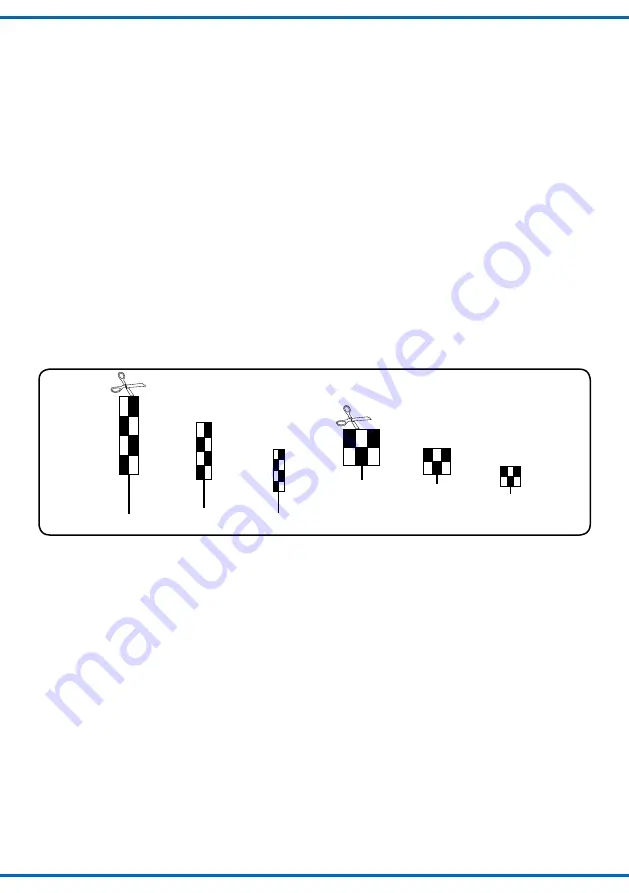
3
3. Einbau
3.1 Aufstellung von Blocksignalen
Um ein Auffahren von Zügen zu verhindern, wird die Gleis
-
anlage beim Vorbild wie auch im Modell in einzelne Stre-
ckenabschnitte („Blöcke”) eingeteilt. In jedem Block darf
sich jeweils nur ein Zug befinden. Der nachfolgende Zug
darf in einen Block erst dann einfahren, wenn der voraus-
fahrende Zug diesen komplett verlassen hat. An jedem
Beginn eines Blocks steht ein Blocksignal, dass dem Loko-
motivführer eventeuell einen Zug im nachfolgenden Block
anzeigt.
Blocksignale gehören zu den Hauptsignalen und sind die
einfachste Ausführung eines Signals in dieser Gruppe. Sie
stehen auf der freien Strecke - in der Regel in Fahrtrich-
tung gesehen rechts vom Gleis.
Wenn das Signal ausnahmsweise einmal nicht unmittel-
bar rechts aufgestellt werden kann, so muss in Höhe des
Signals auf der rechten Seite eine sogenannte Schach-
brett-Tafel aufgestellt werden. Diese sind in H0, TT und N
(Abb.1) abgebildet und können ausgeschnitten, auf eine
Stecknadel geklebt und auf die Anlage gesetzt werden.
Die hohe Ausführung wird bei der Aufstellung rechts au-
ßerhalb der Gleise und die niedrige zwischen zwei Gleisen
verwendet. Letzteres hat nur einen ganz kurzen Mast.
3. Mounting
3.1 Setting-up of block signals
To prevent that a train drives into another, the rail line is
subdivided into separate segments (”blocks”). In each
block there is only one train allowed to be in it. The fol-
lowing train is not allowed to enter the block before the
first train has left it completely. A block signal shows the
engine driver if the following block is occupied or free.
Colour light block signals belong to the group of the main
signals and they are the plainest members of this group.
You can find them at the free parts of the rail lines - most
-
ly at the right side of the rails.
If the signal can not be put up on the right side, a chess-
board-slab has to be put up on this place. You can find
them at the illustrations in H0, TT and N (fig. 1). They can
be cut out, pasted on a pin and put up on your model rail-
way layout. The high model has to be placed at the right
side out of the rails and the lower one between two rails.
The lower slab has only a very short mast.
H0
H0
TT
TT
N
N
Wenn der nachfolgende Block frei ist, so steht das Blocksi-
gnal auf „Fahrt” (Hp1 = grün). Kurz nachdem die Zugspitze
das Blocksignal passiert hat, schaltet das Signal auf „Zug-
halt” (Hp0 = rot) um. Ein nachfolgender Zug muss vor dem
Signal warten. Sobald der erste Zug den Block komplett
verlassen hat, schaltet das Blocksignal auf „Fahrt“ und der
zweite Zug kann in den Block einfahren.
Dieses Block-Sicherungssystem wird auch heute noch
beim Vorbild verwendet und als „Fahren im Raumab-
stand” bezeichnet.
3.2 Bezeichnung von Blocksignalen
Dem Signal ist eine Tafel mit selbstklebenden Bezeich-
nungsschildern beigelegt. Schneiden Sie das gewünschte
Bezeichnungsschild aus und kleben Sie es nach Abziehen
der Schutzfolie auf die Nummerntafel des Signals. Hier eini-
ge Richtlinien zur korrekten Beschriftung von Blocksignalen:
- Selbsttätige Blocksignale werden mit Hilfe von ara-
bischen Zahlen (1, 2, 3,...) bezeichnet.
- In Richtung der Kilometrierung der Strecke wird vor-
wärts gezählt (diese wird als „Zählrichtung“ bezeich-
net), in die andere Richtung rückwärts.
- In Zählrichtung werden ungerade Zahlen (1, 3, 5 ...)
installiert, in der Gegenrichtung die geraden Zahlen
(2, 4, 6 ...).
If the following block is free, the colour light block sig-
nal shows “go” (Hp1=green). After the head of the train
has passed the block signal, it changes over to “stop”
(Hp0=red). A following train ,has to wait in front of the sig
-
nal until the first train has left the block. Then the signal
changes to “go” and the second train is allowed to enter
the block.
This block signalling system is still in use today in the real
world and it is called “Driving with distance spacing“.
3.2 Marking of the block signals
Attached is a board with decals. Cut one of them out and
paste them at the number board. Here are some guide-
lines for the correct inscription of the block signals:
-
Automatical block signals you have to label by arabic
numbers (1, 2, 3,...).
-
In the direction of the line-kilometre it is counted for-
ward (it is called “counting direction”), in the other di-
rection backwards.
-
Use in counting direction odd (1, 3, 5,...) and in the
other direction even numbers (2, 4, 6,...).
Fig. 1
Abb. 1


























